If you really want to keep me busy for hours, just ask me to rank my top 10 favorite cards. I’ll agonize over it endlessly – mostly because my ’90s-’00s playing-era gems and the ultra-modern monsters are constantly duking it out for those top spots.
And sure, scrolling through the photos might make this feel like yet another love letter to Canseco collecting – which, in fairness, it absolutely is. But my hope is that this deeply resonates with anyone who collects across these two eras. Since Canseco is my collecting focus, his cards just happen to be the examples I’m drawing from.
So, what about you? For you steroid-era guys, is the pinnacle of collecting found in the ’90s and early-2000s inserts and parallels – the cards born during a player’s career? Or is it today’s world of ultra-premium, post-career superfractors, bat barrels, knobs, and jumbo patches?
Both eras produced masterpieces, but they carry fundamentally different types of magic. Understanding the difference reveals not just how the hobby evolved, but why certain cards may always reign supreme in long-term desirability.
Playing-Era Cards: The Hobby’s Golden Era of Creativity
If you collect this era, then it is likely you are either chasing some of these for your favorite player, or have some, and they are considered centerpieces in your collection. For me personally, the five shown below mix unicorn-grail energy with unmatched beauty … all without the need for a signature or relic. There are rarer cards out there for sure, and some could even be swapped out, but to me, these cards are the complete package.

The ’90s and early-2000s were a strange, beautiful, experimental era in the hobby.
Card manufacturers were locked in an innovation arms race, pushing boundaries not because the market demanded it, but because every company was fighting to stand out on a crowded shelf.
The result?
A legendary, grail-rich period of cardboard history that simply cannot be replicated. In fact, the more time goes by, the larger the legend grows.
What happened in the ’90s was chaos – the birthplace of manufactured scarcity as we know it.
Still, that early manufactured scarcity looked nothing like today’s fully engineered systems.
There was a Wild West energy to it: incomplete checklists, unpredictable inserts, hidden parallels, pack odds instead of transparent print runs, and a discovery-based culture that unfolded organically over time.
It was scarcity by design, yes – but the experience of chasing those cards feel spontaneous, mysterious, and unscripted in a way modern ultra-premium products simply don’t capture.
5-10 card rainbows of each player in each set with a mere foil color change, and the ability to reasonably expect the same thing year in and year out is absolutely nothing like what the 90s-00s offered. Today’s cards are more like manufactured scarcity 2.0 – a well-oiled machine. Card companies know what ingredients to use, and the recipe is the same year in and year out.
Highlighting the quirkiness of the era perfectly are the beautiful 1998 Skybox E-X 2001 Essential Credentials parallels. They come from a 101 card set where each player was ranked and numbered based upon their star power. The NOW (neon yellow-green) parallel is numbered to /40. Subtract 40 from 101, and you get the FUTURE (neon purple-red) with a serial number of /61. 40 + 61 = 101. Get it? The ONLY reason one of these beauties didn’t make the Fab Five above is because there are two, thus making it literally impossible to choose just one, and we can’t have two of the same clogging up a fab five list, can we?
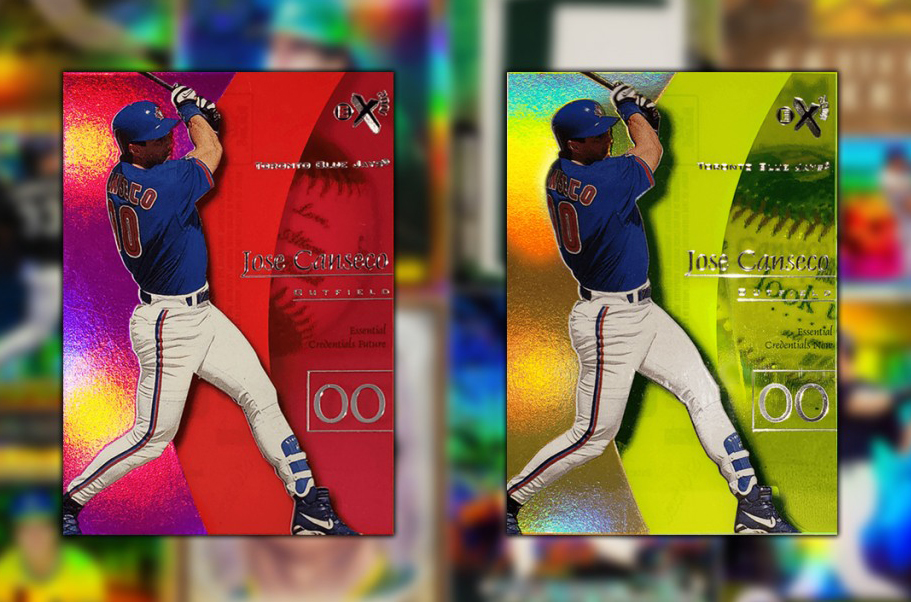
Why playing-era rarity hits different:
- Players on the cards were still playing while you could pull their cards from packs
This is a big one, and I mean a really big one. To me, anyway. There’s something psychologically powerful about holding a card that existed during their career, not created 15 years after they retired. I often imagine the perfect Saturday afternoon: A baseball game on TV, a box of cards in hand, and pulling my favorite player’s card while he just hit a home run. Wow! -
Scarcity is otherworldly
You may not see a grail card for years, or even decades. They can keep you up at night, and haunt you in your dreams. Inserts & parallels from this time period feel mythical. - Limited options
While the 90s-00s card boom offered a ton of options, the number of cards you can chase are extremely finite. Not only can this time period not be matched; it can’t be added to, either.
The Best Kept Secret of 90s-00s cards
Collectors are waking up to the appeal of “career-era” cards, but the real untouched gold mine is the staggering list of first-ever card milestones released during that time. When a card sits at the intersection of a player’s career-era and a significant first-ever, you get a two-tiered combo that’s downright spectacular – yet still largely unknown to the hobby.
What was your favorite player’s first patch card? His first pack-pulled autograph? His first auto-patch?
For years, I didn’t know most of these answers myself. It wasn’t until I went down a deep fact-finding rabbit hole that certain cards jumped from “neat” to full-blown grail status in my mind.
Here are a few examples, and you may want to pay attention, as your favorite player’s “first-evers” might mirror these as well!
Here is his first ever pack-pulled autograph (it is on card, and numbered 33/250!)

First ever autographed relic
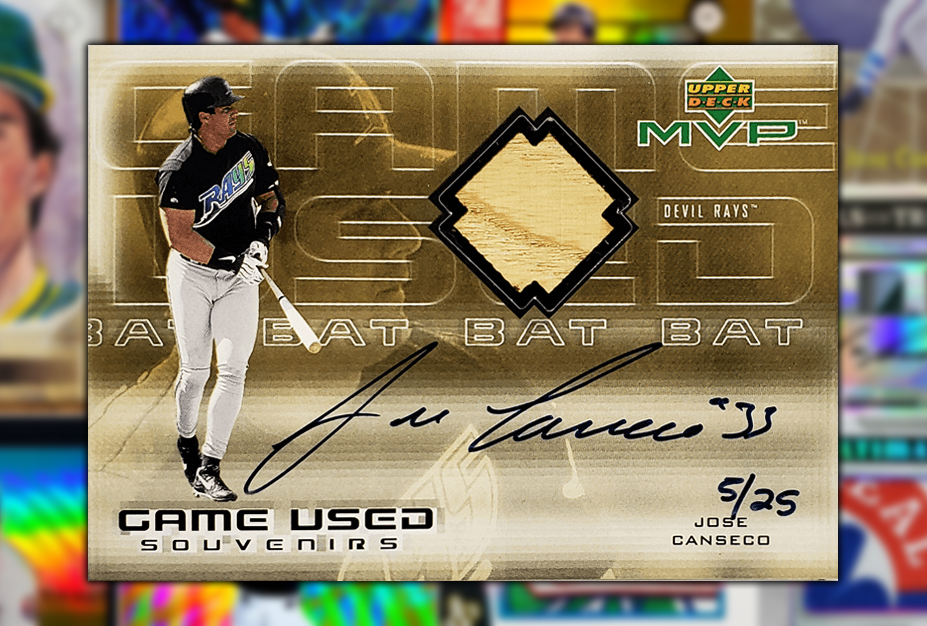
First ever autographed jersey (these can be found with white jersey swatches, and black mesh swatches.) An unnumbered version of these exist as well.

First-ever patch, and hands-down my favorite copy of this card. I had to unload a whole stack of modern heavy-hitters just to bring it home.

His first serial-numbered patch card, and hands-down the most vibrant patch I’ve ever come across. It’s also the only serial-numbered patch he had during his playing days, excluding 1/1s. An unnumbered counterpart exists as well.
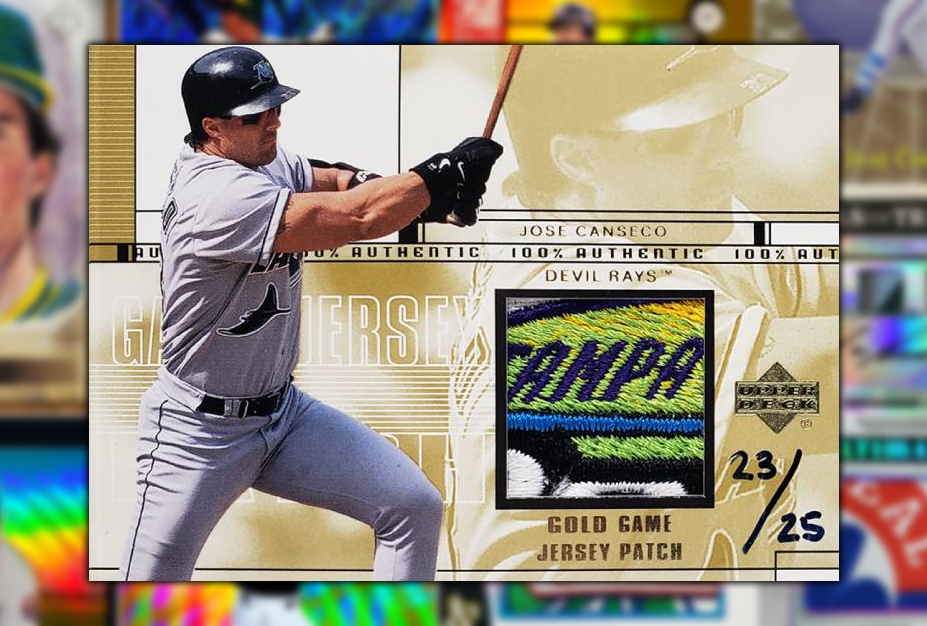
First Autographed Patch Card (and first A’s patch!) – A couple of things make this one special. It was released just months after Canseco announced his retirement, so while it isn’t technically a career-era card, it absolutely carries that same career-era energy – quirks and all.
Though the base version is numbered to /33, the autographed run is limited to 10 copies, and likely five or fewer actually contain patch material. This came from that transitional period before Leaf consistently distinguished between jersey swatches and true patches.
When you factor in the oddball numbering and the roulette style of relic inclusion, it becomes clear just how different this window of card production was compared to the ultra-defined standards we have today.
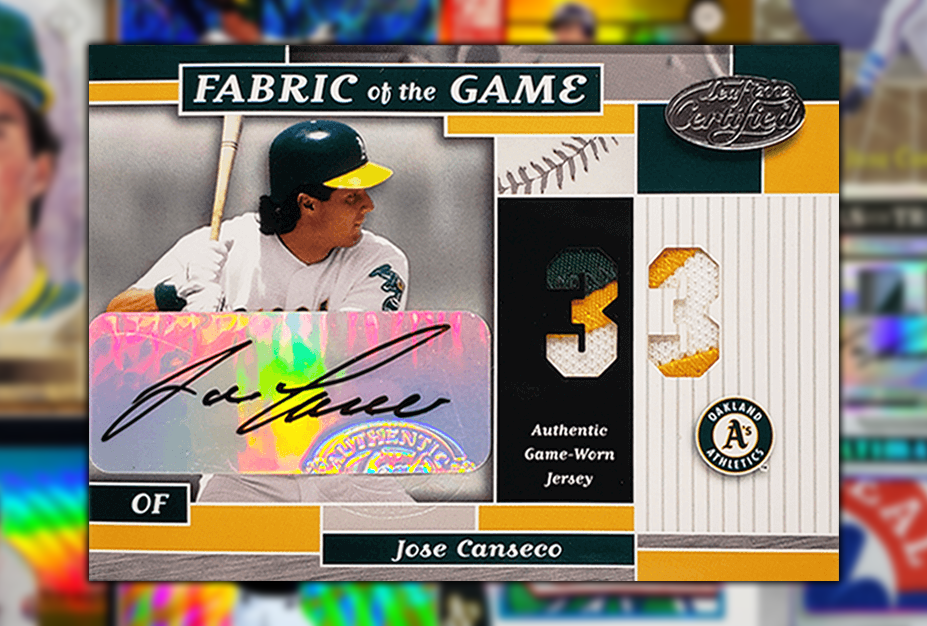
In short:
Playing-era inserts and parallels feel like rare relics from a wild era when nobody realized how big of grail pieces these cards would become.
The irony of it all is that when you talk to people who left the hobby in the early/mid 90s, many of them will emphatically cite that it was largely due to too many new types of cards hitting the shelves. How funny is it that the #1 reason ended up making the time period perhaps the most coveted era for the same demographic.
Post-Career High End: Flash, Technology, and Guaranteed Rarity

Today’s hobby is a different planet…no, a different universe.
Modern high-end products—Topps Sterling, Dynasty, Immaculate, Flawless, National Treasures, Museum Collection, Definitive—generate breathtaking cards:
- Jumbo patches
- 1/1s every direction
- Bat knobs, barrel nameplates
- Booklets
- Buttons
- Laundry Tags
- Superfractors
- Manufactured scarcity that’s intentional, and on auto-pilot
These cards are incredible. They’re built like luxury items, not mass-market trading cards, and also hold some pretty significant Easter eggs within.
This National Treasures Colossal goes beyond an autograph – it holds a massive Rawlings tag sourced from a rookie-year game-used jersey. Identifiable relics can cause the intrigue for certain pieces to skyrocket, especially if you can trace them to specific years/events.
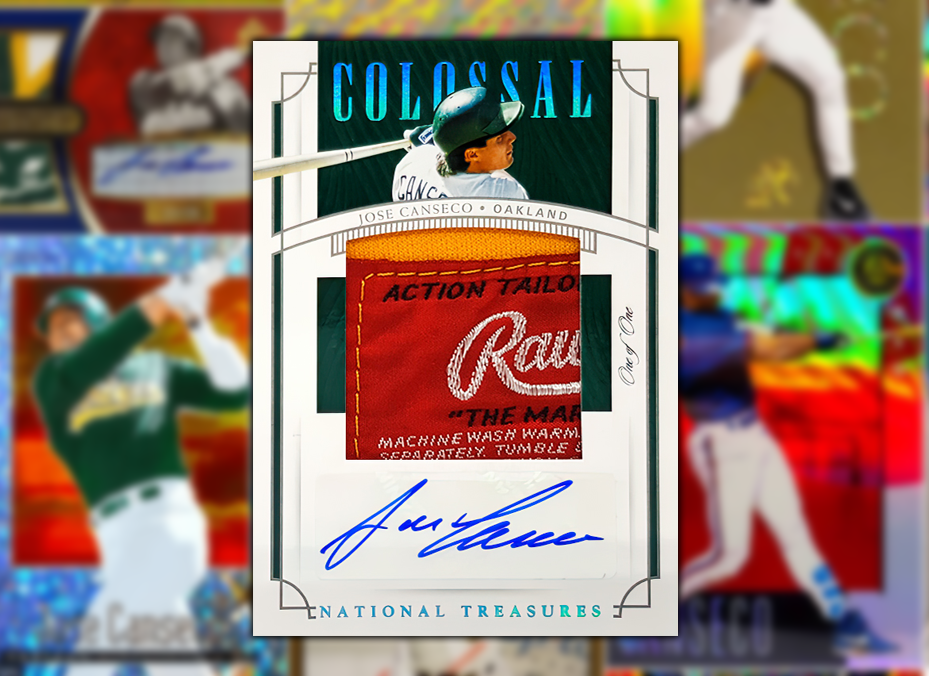
Why modern high-end appeals:
- Monster Game-used patches with identifiable characteristics – sometimes, even down to the specific game.
- Premium Relics – Knobs, barrels, laundry tags, buttons, and more.
- Modern production techniques – foil, embossing, framing, metal cards, even full wood make the cards look like art pieces.
- Collectors love super-premium formats – Topps Sterling-level cards feel like museum artifacts right out of the box.
Make no mistake:
Post-career high-end cards can be museum-worthy gorgeous, extremely valuable, and deeply collectible. Simply put, the WOW factor of some of the newer cards is off the charts!
Pictured below is a rainbow featuring Jose’s largest patch on-card autos.

Here’s a fun experiment: look for cards in your collection with distinctive markings on the relic, then see if you can track down the actual jersey it came from.
When you think of baseball bloopers, one moment always jumps to the front – Jose taking a fly ball off his head. Well… check this out.
After some online sleuthing, I was able to trace this patch back to the exact jersey he was wearing during that play. For me, that’s the kind of discovery that makes collecting electric — a reminder that sometimes the story behind the relic matters even more than the card’s pedigree.
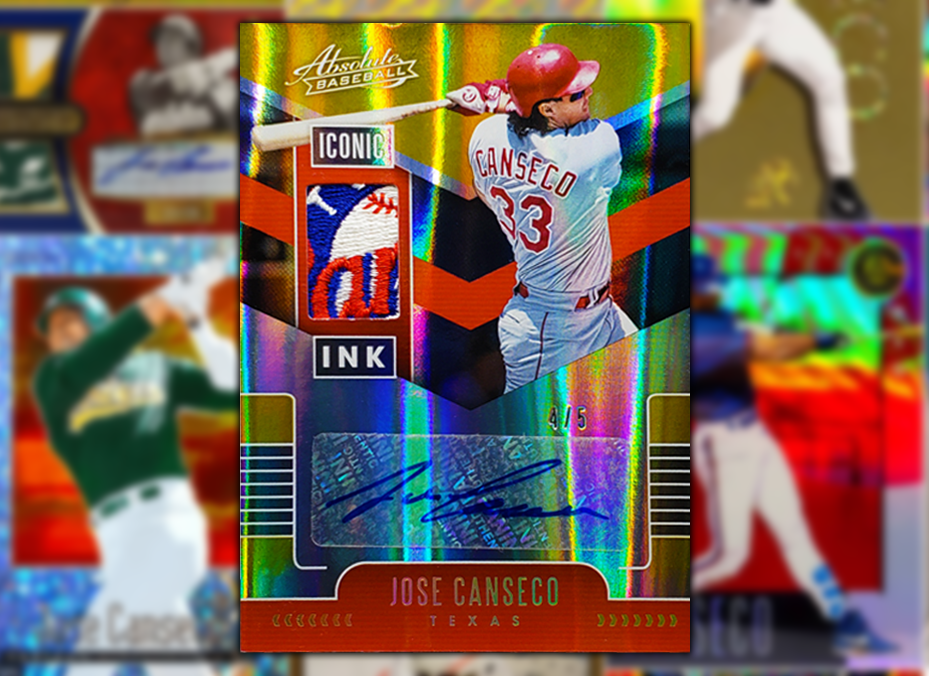
The Real Divide: Early Manufactured Scarcity vs. Fully Engineered Scarcity
Both eras rely on manufactured scarcity – but the experience of that scarcity is radically different.
They don’t have the same organic scarcity as the playing-era stuff that was fighting for oxygen in a crowded, competitive marketplace. Perhaps I should explain “organic scarcity” here, with a working example. If you are looking for a bat barrel of a certain player in a product that is about to drop, you have a very good chance at finding it, and potentially working a deal … all within weeks of the release.
When 1996 Select Certified or 1998 Skybox Metal Universe hit the shelves, there were no You Tube or WhatNot eBay listings to check out. With mirror golds running at 30 copies each, and PMGs at 50 each, you might go years or even decades before you even see a copy of your player.
Taking that a step further, you go into ghost-hunting territory. For Jose Canseco, he has two single digit serial numbered cards that were released during his playing career (1/1s and buybacks notwithstanding) …
1998 Bowman Chrome Golden Anniversary Refractor /5

1999 Fleer Tradition Starting 9 #/9

Today’s modern cards have introduced us to an absolute avalanche of low numbered cards. In fact, Leaf alone has pushed out hundreds of 1/1s for Jose Canseco this past year.
Chaos vs. Design
-
’90s/00s inserts: scarcity with mystery
-
Modern high-end: scarcity with precision
Neither is inherently better — but collectors often form a deeper emotional bond with that early-era “discovered rarity” feeling, where finding a big card feels like stumbling onto buried treasure rather than just sitting on eBay waiting for the inevitable: the card you want from the latest product to pop up.
That’s why:
-
A 1998 PMG /50 will typically beat out the highest-end of 1/1s.
-
A 1996 Certified Mirror Gold /30 feels like you won the lottery.
-
A 1998 Crusade Red /25 still sits at the top of nearly every ’90s player collector’s grail list.
These cards aren’t just rare – they’re career-era artifacts, created when the players were still writing their story, not decades after the fact during a nostalgia boom.
But regardless of which era you collect, both offer collection-defining centerpieces.
So Which Is Better?
Understanding the Strengths of Each Era
There’s no universal “winner” – the two eras deliver fundamentally different types of collecting experiences. But each era has its own distinct advantages, shaped by how scarcity was created and how collectors interact with it. BTW, if you think new 1/1s are tough…try getting low numbered cards made a quarter of a century ago featuring game-used pieces of four GOATS on the same card! At auction, this could be a blood bath.
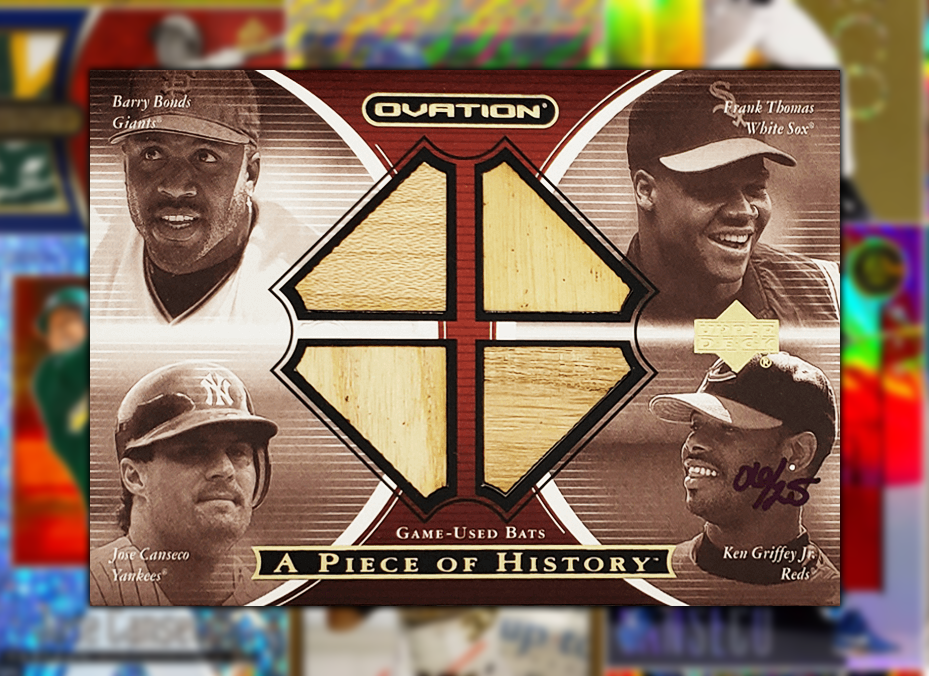
Career-Era Inserts & Parallels Excel At:
-
Historical importance
These cards were produced while the player’s story was still being written. They also produced many “firsts” – first 1/1s, jersey cards, auto cards, patch cards, etc. They’re the bridge between a player’s actual greatness and the hobby’s golden era of creativity. -
First-generation manufactured scarcity
Serial numbering and ultra-rare inserts existed, but with limited transparency and unpredictability that made hits feel like discoveries. It was a real-time testing ground into uncharted territory. If you miss out on a Red Crusade, you might be upset that you missed out on THE Crusade. If you miss out on a barrel card, you’ll be upset, but there is always next year to pull another. -
Cultural resonance
These cards introduced us to that feeling of opening a pack and having a real shot at something truly valuable – the ones that became legends over time. Collection defining. -
Authenticity of the chase
The hunt feels wild, unstructured, and often accidental – the rarity was intentional, but the experience feels organic. -
Hardcore collector demand
People don’t chase these because a sell sheet told them to – they chase them because decades of hobby history made them iconic. - Countless ghost stories and legends
Part of the fun comes from the stories collectors share with each other – catching a glimpse of a certain card, or navigating the ridiculous hoops required to land those specialty mail-in releases.

Post-Career Modern High-End Cards Excel At:
-
Visual power and presentation
Foil, embossing, metal, shadowboxes, frames – they’re built to impress instantly. -
Elite patch quality
Multi-color patches, logo pieces, bat knobs, barrels, and significant documented event specific patches - Nostalgia
It’s true that the 90s-00s card era cannot be replicated, however, modern cards to a wonderful job at capturing our nostalgia in a way the previous era didn’t. -
Autograph availability
On-card signatures across dozens of brands give collectors more chances to get premium player autos. -
Advanced production technology
Modern printing allows for striking designs that were impossible 20+ years ago. -
Immediate “wow factor”
These cards hit hard visually the moment you see them – they look like high-end art pieces right out of the pack.
Bottom Line
They’re not competitors (though our wallets will disagree) – they’re two different expressions of what the hobby can be:
-
Career-era inserts bottle the innovation and unpredictability of a moment when your favorite player was still lacing up for the game that night.
-
Modern high-end represents the polished, luxury version of the hobby – engineered elegance with stunning aesthetics and guaranteed premium hits.
Both lanes serve different collectors, and both matter. The magic comes from deciding which version of “rare” speaks to you.
Final Thoughts: The hobby needs both eras (and so do I)
Today’s patch autos and 1/1s keep the hobby luxurious, exciting, and visually bold.
But the inserts and parallels of the ’90s-’00s take us back to where innovation sparked, at a time when our favorite players were still shaping their legacy.
In the end, the best collections don’t choose sides.
They embrace both chapters of the player’s story:
-
The cards produced when the legend was being written, and
-
The ultra-premium tributes crafted long after the dust settled.
So, with that said, which time period do you prefer, and which do you think will stand the test of time? Will the cards of the 2020s be held with such reverence decades from now? Time will tell. In the meantime, keep collecting what you like.


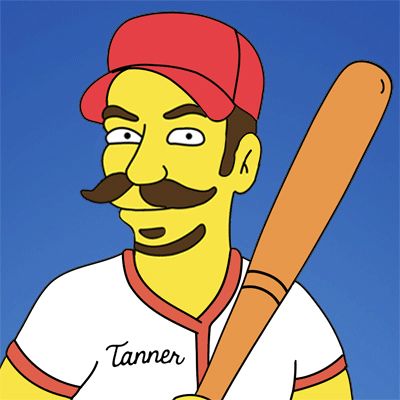

Leave A Comment
You must be logged in to post a comment.